Kandyk: varieties, selection, cultivation, breeding

To make the garden look not only beautiful, but also dazzle with its variety of colors, experienced gardeners recommend choosing the kandyk when creating a beautiful landscape. With the help of this plant, you will be able to bring to life even the most daring ideas. This plant is somewhat reminiscent of a small lily, which is capable of pleasing the eye in early spring.
These bright and at the same time delicate flowers are among the first to appear.



Description
Kandyk became known as early as the 1st century BC. Basically, the plant grows within mountain forests. Flowering occurs from late April to early May. Basically, all species and most of the varieties are undersized, their stem height reaches no more than 30 cm.However, there are also tall plants that can reach up to 60 cm.
An annual egg-shaped bulb, but foliage can be of several varieties: petiolate, opposite, elongated or ovate-lanceolate. And also it can be either plain or with white spots. Two leaves grow at the base of the stem.



There is basically one flower, but there are times when several grows.
The petiole is rather large and consists of 6 petals, which are brought together at the very base and form a bell shape, and those that are higher diverge, bending towards the outside.
The leaves are quite long, they can grow from 18 to 20 mm. The color of the petals can be pink, yellow or white. On the inner leaves, which are located near the petiole, there is a transverse fold at the very base. Below this fold there are small pits. In total, the flower has 6 stamens, which have linear-oblong anthers. The threads at the base are linear in shape, which are spindle-shaped-swollen in the middle, and those at the very top are thin. The column is filiform, it increases in diameter towards the crown, and includes a tripartite stigma (usually with bilateral lobes). The fruit is presented in an obovate box with a small number of seeds.



Types and varieties
In total, there are 29 types of kandyk, of which almost all can be grown as ornamental plants. It should be noted that 3 varieties of erythronium are listed in the Red Book of Russia: Caucasian, Japanese and Siberian. To understand how each species differs from each other, you should familiarize yourself with each of them in more detail.

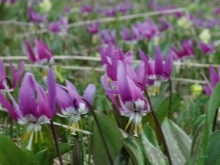

Caucasian
This type of plant in natural habitat is widespread in the territory of Western Transcaucasia, namely, within mountain forests. It is necessary to highlight such features of the Caucasian kandyk species as:
- the shape of the bulb can be of two varieties (oblong or ovoid);
- stem height - considered a low-growing plant, the maximum stem length is up to 25 cm;
- the foliage is oblong and resembles the shape of a chicken egg, with small spots; petiole embracing, petals have a pale shade of yellow or white;
- the flowers are honey-colored on the inside and magenta on the front.
In addition, the Caucasian kandyk has a rather low level of frost resistance, therefore, with the arrival of cold weather, the flowers should be well insulated.
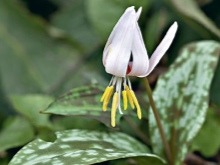


Siberian
The natural habitat of this species is in the south of Siberia and Mongolia.In addition, flowers of this species can grow in clearings of coniferous or mixed forests in Altai. This type of erythronium has such characteristic features as:
- a cylinder-shaped bulb with a delicate structure;
- stem - undersized bush with a height of 12 to 35 cm;
- leaves - a pair of opposite plates, which have the shape of an ellipse (narrowed upwards, with a sharp tip); the color is maroon, resembles a marble coating;
- the flowers are drooping, the petals grow up to 8 cm of white or purple flowers, the base is yellow with a dark speck; white pistils, golden filaments.
Popular varieties: "Lady in red", "Snow of Altai", "White Fang".



Japanese
Plants of this species are common in the Kuril Islands, as well as in Korea, Sakhalin and, of course, in Japan. Like many other varieties, the Japanese kandyk is considered a highly decorative plant, which does not differ in its frost resistance. The following flower parameters should also be highlighted:
- the shape of the bulb is cylindrical-lanceolate;
- stem of medium thickness; the maximum plant length can reach 30 cm;
- leaves are narrow and oblong, grow up to 12 cm;
- one flower, drooping; purple petals.



Tuolumni
In the wild, flowers of the Kandyk Tuolumni species grow mainly at the foot of the Sierra Nevada Mountains. The characteristic features of this variety are as follows:
- stem - maximum height is about 30–40 cm;
- foliage with long petiolate and rich green color; the plates are characterized by a lanceolate or obverse-lanceolate shape, their length can reach 30 cm;
- flowers - there may be one or more flowers of a bright golden hue with a yellow-green base.
It is customary to distinguish the two most common varieties in Russia: "Pagoda" with lemon flowers and "Congo" with dirty yellow flower petals and brown-red veins.

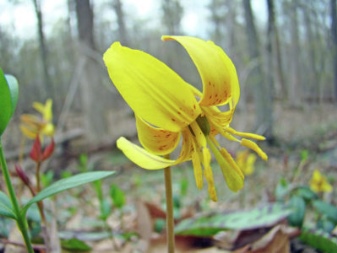
California
The name of this species speaks for itself. These flowers can be found in their natural habitat within California. The features of the variety are as follows:
- the stem height is up to 35 cm;
- oblong leaves with spots can grow up to 10 cm;
- winged petioles;
- several flowers can grow on one stem; petals in cream tones with a yellow tint and an orange base.
Among gardeners, the following varieties of kandyka are especially popular: "White Beauty" with snow-white flowers and a dark horizontal stripe in the middle, as well as "Harvington Snowgos" with large cream-colored flowers characteristic of this variety and a lemon base.


European
Flowers of this variety can be found not only in Europe, but also within the Alps at an altitude of up to 2 thousand meters, as well as in Western Ukraine. For the European Kandyk, a subtropical and temperate climate is suitable. It has the following characteristics:
- the stem is pale pink; maximum height - 30 cm;
- leaves are broadly shaped, the plate narrows closer to the petiole, grows at the base of the stem; color green with purple blotches;
- petiole grooved;
- the flower, as a rule, is one and drooping; lanceolate petals with a sharpening closer at the tips, which are turned in the opposite direction; colors: pink, white and purple.
Flowers of this variety are distinguished by good frost resistance and high decorative effect.
Gardeners distinguish the following varieties: Pink Perfection pink, Snowlake with white flowers and Rose Queen with pink petals.
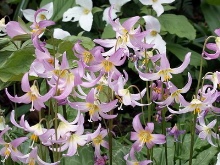


Other
In addition to the above species of such a plant as kandyk, there are also a huge variety of both species and varieties. For example, erythronium american, which can be found within the United States or Canada at an altitude of 1.5 thousand meters, usually grow up to 20 cm in height with amber or purple flowers. Kandyk whitish in its place of origin and in some parameters it is similar to American erythronium. The main differences include the absence of blades in the petiole leaves in varieties. The color of the flowers can be different: white, blue, pink. And a view like kandyk multi-stem can accommodate up to 3 flowers on one stem. Their color is usually creamy with an orange base. With the process of wilting, it acquires a different color - light pink.



Landing rules
Compliance with all planting rules is 50% of the success of all further plant growth. For all actions to be performed correctly, you should adhere to the following simple step-by-step instructions:
- already ripe flower seeds should be spread out at a distance between each sowing material no closer than 5 cm;
- place them in the pits to a depth of 3 cm, so that the distance between them is from 10 cm, after which the grooves can be repaired;
- We water abundantly the place where our plants were planted.
With the arrival of winter, the site should be wrapped up only if the season promises to be frosty and without snow. The first shoots can be seen by mid-spring. Their height should be at least 4 cm. If the sprouts are smaller or do not sprout at all, then they must be well moistened and "fed" with fertilizer. If you decide to plant kandyk bulbs, then you need to pay special attention to some features. For example, European-Asian bulbs should be submerged to a depth of approximately 15 cm, with at least 15 cm spacing between each bulb.American varieties are planted 20 cm deep with 15 cm spacing, as is the case with Asian-European hybrids. ...
After planting, the area must be watered with plenty of water.


Follow-up care
Growing erythronium outdoors implies the need to care for the plant throughout its life.
Watering
In the spring, a period of active growth begins, but since as the snow melts, water enters the soil, thus the plant is able to enrich the amount of moisture it needs from melt water. Active watering can be started in late spring if it is not rainy. After each irrigation or rain, the soil should be loosened and weeds should be removed, if any.


Top dressing
During the first year after planting, the plant does not need additional fertilization, since all the fertilizing that was applied at the time of planting will be enough for the whole year.
Then you will need to resort to mulching, and as a top dressing, use fertilizers special for kandyk with a mineral base.

Preparing for winter
Despite the fact that a plant like kandyk is one of the first to emerge with the arrival of spring, it still cannot be called a flower with good frost resistance. If you decide to plant this beautiful plant in your garden, then it is imperative to insulate it with the arrival of the first frost. If the winter should not be too cold and at the same time snowy, then the fragile plant will not need shelter. Its role will be played by the thickness of snow. Otherwise, as insulation, experts recommend abundantly filling the place where the flower grows with a layer of spruce branches or dry foliage. If we are talking about such varieties of an ornamental plant, which are more or less distinguished by their frost resistance, then the "blanket" can be made a little less thick. The insulation layer should be removed not earlier than the moment the snowdrifts melt and spring warmth comes.


Disease and pest control
First of all, it should be said that this plant is not prone to disease or pest damage. Harm can only be caused by those insects or rodents that live in the soil itself, for example, moles, bears or shrews. However, it is sometimes much more difficult to deal with such pests than with other insects. In order to save money, many experienced gardeners resort to folk and cheap methods of eliminating parasites.
You can destroy the masonry of a bear if you loosen the ground between the flowers to a depth of 15 cm.You can also dig a plastic bottle cut on both sides around each bulb. This life hack will block all the paths of the pest to the plant bulb.
As for moles and shrews, then in this case, you should start building special home-made devices. To do this, you need iron rods. Their length should be between 1 and 1.5 meters. You should stick them into the ground in those places where pests are supposed to gather, you need to stick them in half of the total length. On those ends that remain free, you must put on an empty tin can.
Thanks to the wind and the contact of metals, vibrations will be generated, which will help scare away pests from the plant. And you can also wrap the rods with textiles, having previously moistened it in dust so that the smell scares away insects and rodents.


Reproduction
Kandyk is considered a perennial flower that can grow in the same place for 4–5 years. After this period, the time comes for transplanting the plant, and at the same time for its reproduction. Erythronium is propagated by dividing the bulb. Experienced gardeners recommend engaging in the breeding process from late July to early August. It is at this time that the flower is in a state suitable for reproduction.
By this period, the leaves of the kandyk should turn yellow. The bulbs will be able to recover after the last flowering period of the plant. When the bulbs are dug out, the children should be separated from them and then the breaks should be treated with coal powder. The resulting planting material should be immediately planted in pre-prepared holes with fertilizer. Prolonged exposure of the bulbs to the open air damages their structure. This is due to the fact that they are not covered with a protective layer of husk, so they begin to dry instantly from the wind. If you need to store the planting material for some time, you should put them for long-term storage in a container with wet sandy cover or peat.
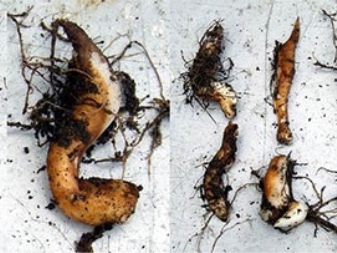

Use in landscape design
Due to the huge variety of both varieties of this ornamental plant, and varieties with their extraordinary colors, kandyk can be used everywhere. To create a beautiful landscape using this type of plant, you can resort to planting it on an alpine slide or in a rocky garden. In addition, this flower will look harmoniously in flower beds, mixborders or even rabat beds. Due to its high decorativeness and "livability" with other plant species, erythronium can be planted next to Caucasian Arabis, Trillum, Iberis and Liverwort. As for the same early plants, you can plant kandyk next to muscari, chiondoksia, pushkinia and brandushia.
This kind of decorative flower near a cotoneaster, juniper or holly mahonia will look quite advantageous.
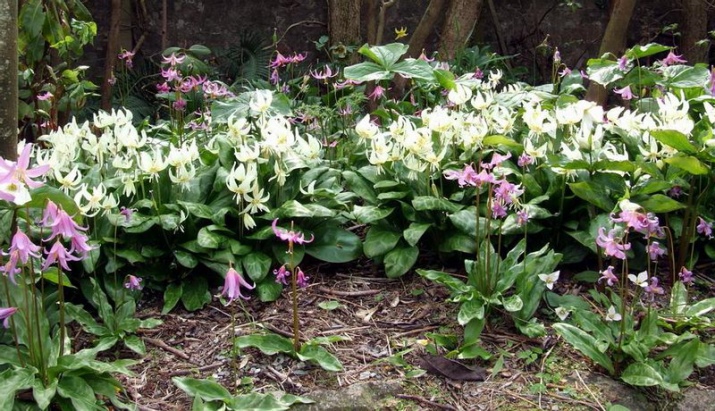


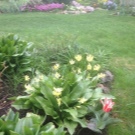


The use of kandyk is described below.







































































































The comment was sent successfully.